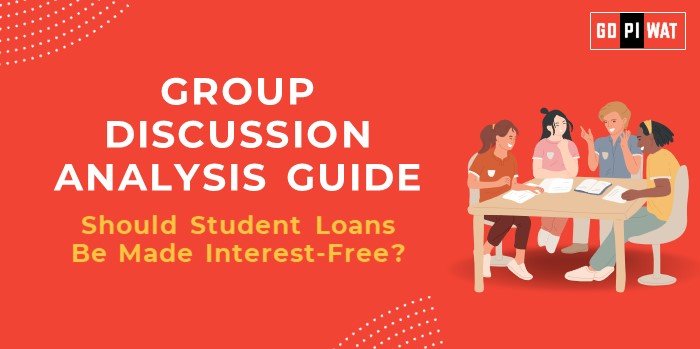📋 Should Student Loans Be Made Interest-Free?
🌐 Introduction to the Topic
Opening Context: With the rising cost of higher education, student loans have become a significant factor in the financial planning of millions. Making these loans interest-free could change the landscape of educational access and affordability, impacting individuals and national economic dynamics. The debate around interest-free student loans weighs on financial stability versus equitable access to education, making it a highly relevant topic for B-school candidates.
Topic Background: Student loans in many countries carry interest rates that burden graduates for years. Interest-free loans could alleviate some financial stress, but they also pose sustainability concerns for financial institutions and the economy. Recent trends toward debt forgiveness and the rising demand for accessible education intensify this discussion, as policymakers explore ways to balance economic pressures and public good.
📊 Quick Facts and Key Statistics
- 📉 US Student Loan Debt: Exceeds $1.6 trillion – Reflects the immense financial load on graduates.
- 📊 Average Interest Rate: 4-7% in many countries – Adds significantly to repayment costs.
- 📈 Global Education Cost Trends: Rising annually by 3-4% – Drives higher demand for affordable loans.
- 🌍 Countries with Interest-Free Models: Some Nordic countries – Showcases alternative approaches to student debt management.
👥 Stakeholders and Their Roles
- 🏛️ Government: May fund or subsidize interest-free loans to support equitable education.
- 🏦 Banks and Financial Institutions: Face risks in revenue loss if loans become interest-free.
- 🎓 Students and Families: Direct beneficiaries who would experience reduced repayment burdens.
- 🏫 Educational Institutions: Impacted indirectly as they rely on enrollment funded by loans.
- 🌏 Society and Economy: Benefit from a better-educated workforce but may see budget constraints if government-backed loans increase.
🏆 Achievements and Challenges
✨ Achievements
- 📈 Educational Accessibility: Some countries offer low or zero-interest loans, which have broadened access to education.
- 💰 Economic Boost: Reduced debt burden enables graduates to contribute more effectively to the economy.
- 🔝 Social Mobility: Interest-free loans increase opportunities for lower-income students to attend higher education.
⚠️ Challenges
- 📉 Financial Sustainability: Without interest, loan programs may face funding issues.
- ⚠️ Moral Hazard: Borrowers may take on more debt than necessary, expecting lenient terms.
- 💸 Limited Public Funding: In countries with restricted budgets, supporting interest-free loans could strain other social programs.
Global Comparisons: Nordic countries like Denmark and Norway offer minimal interest loans, supported by high taxes and state funding, showcasing a model for free education access. In contrast, the US and UK rely on high-interest student loan models, which generate substantial returns for lenders but impose significant financial strain on graduates.
💡 Structured Arguments for Discussion
- ✔️ Supporting Stance: “Making student loans interest-free would enable more students to pursue higher education without the fear of long-term financial hardship.”
- ❌ Opposing Stance: “Interest-free loans might lead to unsustainable government debt or losses for private lenders, limiting the program’s longevity.”
- ⚖️ Balanced Perspective: “Interest-free student loans could be feasible if managed through limited borrowing amounts or targeted for specific lower-income groups.”
🔑 Effective Discussion Approaches
- 📊 Opening Approaches:
- Data Impact: “With $1.6 trillion in student loan debt, the US exemplifies the financial burden interest-bearing loans impose.”
- Contrast Approach: “While Nordic countries use interest-free loans, others rely on high-interest rates, leading to significant debt.”
- Policy Focus: “Evaluating interest-free loans requires understanding their economic impact and feasibility in different economic systems.”
- 🛠️ Counter-Argument Handling: Recognize the budgetary concerns of making loans interest-free, then suggest targeted or income-based repayment plans as alternatives.
📈 Strategic Analysis of Strengths and Weaknesses
- 💪 Strengths: Increases accessibility to education, reduces financial burden, enhances economic productivity.
- 💔 Weaknesses: Potential strain on government budgets, risk to financial institutions’ sustainability.
- 🌟 Opportunities: Potential for innovative loan structures, promotes a more educated workforce.
- ⚡ Threats: Moral hazard, unsustainable debt accumulation for the government.
📚 Connecting with B-School Applications
- 💼 Real-World Applications: Students can explore models of sustainable financing and their impact on socioeconomic mobility in finance or public policy classes.
- ❓ Sample Interview Questions:
- “How do interest-free loans affect a country’s economic structure?”
- “Should banks or governments bear the burden of funding interest-free loans?”
- 🎓 Insights for B-School Students: Provides real-world examples of financial risk management, allows critical assessment of social policy versus economic stability.


